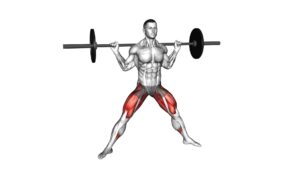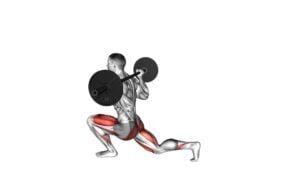Barbell Split Squat – Video Exercise Guide & Tips

Looking to strengthen your legs and improve your overall lower body strength? Then the Barbell Split Squat is the exercise for you!
Watch This Exercise Video
In this video exercise guide, we'll show you the proper form and technique to maximize your results.
With variations to challenge yourself and tips to avoid common mistakes, you'll be well on your way to achieving your fitness goals.
Get ready to take your leg workout to the next level!
Key Takeaways
- The Barbell Split Squat increases muscular strength and engages multiple lower body muscles.
- It improves core stability and enhances overall athletic performance.
- Proper form and technique are important to maintain proper knee alignment, depth, and stability.
- Variations of the Barbell Split Squat can be used to challenge yourself and improve balance and stability.
Benefits of the Barbell Split Squat
You can achieve numerous benefits by incorporating the barbell split squat into your workout routine. This exercise is an excellent way to increase your muscular strength and improve your core stability. When you perform the barbell split squat, you're engaging multiple muscles in your lower body, including your quads, glutes, and hamstrings. By targeting these muscle groups, you can develop greater strength and power, which can enhance your overall athletic performance.
Additionally, the barbell split squat requires you to maintain balance and stability, which activates your core muscles and promotes better core strength. Strengthening your core isn't only beneficial for aesthetic reasons but also for improving your posture and reducing the risk of injury.
Transitioning into the subsequent section about proper form and technique, it's crucial to ensure you're performing the barbell split squat correctly to maximize its benefits.
Proper Form and Technique
To perform the barbell split squat with proper form and technique, it's essential to focus on maintaining a stable and balanced position throughout the exercise. Here are a few key tips to help you achieve this:
- Start by standing with your feet hip-width apart and your back straight.
- Take a big step forward with one foot, keeping your toes pointing forward and your heel planted firmly on the ground.
- Lower your body by bending both knees until your back knee is almost touching the ground, making sure to keep your front knee in line with your toes.
- As you lower your body, engage your core muscles and maintain an upright posture.
- Push through your front heel to return to the starting position, using your glutes and quadriceps to power the movement.
- Repeat the exercise on the other leg.
By focusing on maintaining a stable and balanced position throughout the barbell split squat, you not only improve your balance but also activate the muscles in your legs and glutes more effectively. This will help you build strength and stability in your lower body.
Now that you have mastered the proper form and technique of the barbell split squat, let's move on to exploring variations that will challenge you even further.
Variations to Challenge Yourself
To challenge yourself further, consider incorporating variations of the barbell split squat into your workout routine.
Advanced modifications can help you take your squatting game to the next level and continue making progress.
One way to challenge yourself is by adding resistance to the exercise. Instead of using just your body weight, you can hold dumbbells or a barbell on your shoulders while performing the split squat. This added weight will increase the intensity and engage your muscles even more.
Another way to make the exercise more challenging is by elevating your front foot. You can place your front foot on a step or a platform, which will increase the range of motion and require more strength and stability.
Additionally, you can try performing the split squat with a deficit. This means standing on an elevated surface, such as a step, while performing the exercise. This variation will further engage your muscles and challenge your balance.
Remember to always maintain proper form and technique while performing these advanced modifications to ensure safety and effectiveness.
Common Mistakes to Avoid
To maximize the effectiveness of your barbell split squat and prevent potential injuries, it's important to be aware of common mistakes that you should avoid. Here are three common mistakes to watch out for when performing the barbell split squat:
- Improper knee alignment: One common mistake is allowing your knee to cave inwards or extend past your toes. This places unnecessary stress on your knee joint and can lead to pain or injury. Ensure that your knee stays in line with your toes throughout the movement.
- Insufficient depth: Another mistake isn't going deep enough into the squat. Failing to reach a proper depth limits the activation of your glutes and hamstrings. Aim to lower your back knee until it almost touches the floor, while keeping your front knee at a 90-degree angle.
- Lack of stability: Many people neglect the importance of maintaining stability throughout the exercise. Avoid leaning too far forward or backward, as this can compromise your balance and increase the risk of falling or straining your muscles.
By avoiding these common mistakes and focusing on proper technique, you can maximize the benefits of the barbell split squat and reduce the risk of injury.
Now, let's move on to the next section about tips for maximizing your results.
Tips for Maximizing Your Results
To maximize your results with the barbell split squat, focus on these key tips.
First and foremost, pay attention to your nutrition. To promote muscle growth, make sure you're consuming enough protein. Aim for about 1 gram of protein per pound of body weight per day. Include lean sources such as chicken, fish, tofu, and beans in your diet. Additionally, fuel your workouts with complex carbohydrates like whole grains, fruits, and vegetables. These will provide you with the energy you need to perform your best during your split squat sessions.
Another important tip is to stay motivated during your workout routine. Set specific goals and track your progress. This will help you stay focused and give you a sense of accomplishment as you reach each milestone. Find a workout buddy or join a fitness community to stay accountable and motivated. Surround yourself with positive influences that will inspire and encourage you on your fitness journey.
Lastly, mix up your routine to keep things interesting and challenge your muscles. Incorporate different variations of the split squat, such as using dumbbells or kettlebells, or adding a jump at the top of the movement. This will prevent your body from adapting to the same routine and help you continuously make progress.
Frequently Asked Questions
How Many Sets and Reps Should I Do When Performing the Barbell Split Squat?
When performing the barbell split squat, it's important to consider the suitable rep range for optimal results. The number of sets and reps will depend on your fitness level and goals. Generally, starting with 3-4 sets of 8-12 reps is a good guideline.
Incorporating barbell split squats into your workout routine can benefit you in various ways. It targets multiple muscle groups, improves balance and stability, and increases lower body strength.
Is the Barbell Split Squat Suitable for Beginners or Should It Only Be Done by Advanced Individuals?
The barbell split squat can be suitable for beginners, but it's important to start with beginner modifications.
This exercise targets your legs and helps improve balance and stability.
To avoid common mistakes, make sure your front knee is aligned with your ankle and not going past your toes. Keep your back straight and engage your core throughout the movement.
Start with lighter weights and gradually increase as you get more comfortable and stronger.
Can the Barbell Split Squat Help Improve My Balance and Stability?
Improving balance and stability with the barbell split squat can be highly beneficial for you. By incorporating this exercise into your workout routine, you can strengthen the muscles in your lower body and core, which are essential for maintaining balance.
The barbell split squat also challenges your stability, helping to improve your overall balance. Regular practice of this exercise can lead to increased stability, making everyday activities easier and reducing the risk of falls or injuries.
What Muscles Does the Barbell Split Squat Primarily Target?
The barbell split squat primarily targets your quadriceps, glutes, and hamstrings. This exercise is a great way to build lower body strength and stability.
By incorporating different variations of the barbell split squat, you can target specific muscle groups and challenge your balance even more.
The benefits of the barbell split squat include improved muscle strength, increased stability, and enhanced athletic performance.
Can I Use Dumbbells Instead of a Barbell for the Split Squat Exercise?
Yes, you can definitely use dumbbells instead of a barbell for the split squat exercise. Using dumbbells in split squats offers various benefits, such as improved balance, increased muscle activation, and the ability to target each leg individually.
Dumbbells also allow for a more natural range of motion and can be adjusted to suit your strength level.
Conclusion
To conclude, the barbell split squat is an effective exercise that offers numerous benefits, including improved lower body strength and stability.
By following proper form and technique, avoiding common mistakes, and adding variations to challenge yourself, you can maximize your results.
Remember to start with lighter weights and gradually increase as you become more comfortable.
Incorporating this exercise into your routine will help you achieve your fitness goals and enhance your overall physical performance.

Author
Years ago, the spark of my life’s passion ignited in my mind the moment I stepped into the local gym for the first time. The inaugural bead of perspiration, the initial endeavor, the very first surge of endorphins, and a sense of pride that washed over me post-workout marked the beginning of my deep-seated interest in strength sports, fitness, and sports nutrition. This very curiosity blossomed rapidly into a profound fascination, propelling me to earn a Master’s degree in Physical Education from the Academy of Physical Education in Krakow, followed by a Sports Manager diploma from the Jagiellonian University. My journey of growth led me to gain more specialized qualifications, such as being a certified personal trainer with a focus on sports dietetics, a lifeguard, and an instructor for wellness and corrective gymnastics. Theoretical knowledge paired seamlessly with practical experience, reinforcing my belief that the transformation of individuals under my guidance was also a reflection of my personal growth. This belief holds true even today. Each day, I strive to push the boundaries and explore new realms. These realms gently elevate me to greater heights. The unique combination of passion for my field and the continuous quest for growth fuels my drive to break new ground.







